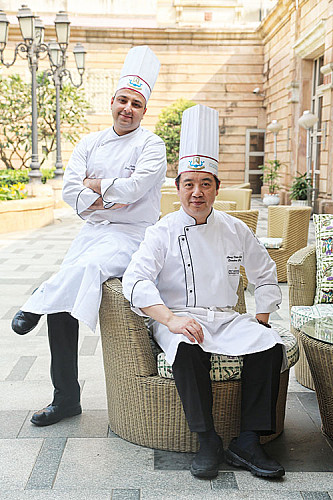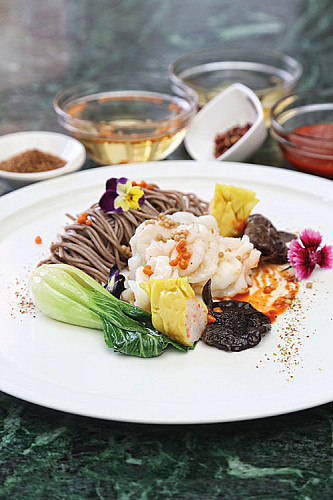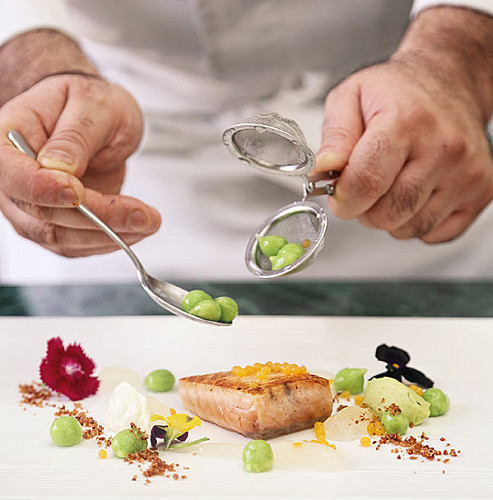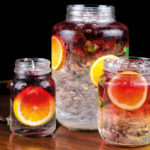Two Lip-Smacking Recipes For Lovers Of Sea Food

It’s been a while since I was last enveloped by the synthesis of Indian grandeur and European grace that the ITC Maratha is so famous for. Reacquainting myself with the signature jharokas, exquisite art and soothing white spaces, I make a beeline for Pan Asian — one of my all-time favourite Mumbai restaurants — where Chef Liang Xiao Qing is busy creating some stomach-rumbling aromas at a blazing wok. A Beijing-born culinary bigwig, he became a high-profile chef in China when he was merely 26 years old, and has since garnered numerous accolades while extensively travelling the world. Proficient in Sichuan, Guangdong and Beijing cooking styles, Chef Qing is hailed by the Chinese government as a global ambassador of the country’s culinary arts. “The wok is like a wizard’s cauldron!” he exclaims over the buzzing kitchen and sizzling fire. It’s an exciting day; not only because we get to watch him and the hotel’s executive sous chef in an Asian-versus-Italian food face-off, but also because Verve is about to break its own mould. As opposed to giving each participating chef two common ingredients to work with, we’re shifting the focus to techniques…spherification and gelation, specifically. What’s life without a little experimentation, right?
Armed with a syringe and a winning energy, Chef Anshul Dhyani joins us, matching my anticipation for the challenge ahead. “I like these techniques because of the wow factor and element of surprise that they add to the final product,” he tells me. An IHM Mumbai alumnus, Dhyani started his career at The Taj Mahal Palace, Mumbai, working for four-and-a-half years at the now-closed luxury European restaurant Zodiac Grill. If that wasn’t an impressive enough start, the shy yet shrewd cook then moved to the UK to work with Michelin-star chef Raymond Blanc for four years followed by a stint with another Michelin-star chef, Michael Caines.
By now, the smell of wonderfully seasoned prawns has made me considerably impatient, so the sight of the impeccably plated Chinese dish is a tremendously welcome one. Besides working with very contemporary techniques that create a chemical transformation of the elements involved, both chefs are also dealing with extremely fresh ingredients, as they always do. Qing presents steamed prawns with chilli garlic gel, oyster caviar, prawn dumplings and black fungus…and it’s stunning! The visual balance of colours and shapes echoes the subtle yet ingenious interplay of flavours and textures, fulfilling its creator’s aim to bring out the best of locally sourced ingredients. “The chilli gel and the oyster caviar give the dish a much-needed punch and balance the sweetness of the prawns,” the chef accurately explains, and I fervently agree as I work my way around the plate. Dhyani isn’t far behind, distracting me with some very cool spheres he’s working on. Having boiled, blended and finely strained green peas, he has the puree in a syringe and is dropping it a little at a time into an algin bath — fascinatingly causing it to form pea-like spheres! “These are basically deconstructed-reconstructed green peas,” he grins.
Intricate and stimulating, Dhyani’s plate of home-cured salmon, green pea mousse, horseradish cream, citrus caviar, lemon gel and bacon soil features a lot of elements which, when tasted together, create a true sensory symphony. The protagonist on the plate may be the salmon — cured overnight and then lightly seared so it stays pink on the inside — but, as the creator explains, “The dill and orange in the cure work their magic to elevate the protein while the sweetness of the peas, pungency of the horseradish and acidity of the lemon perfectly balance the subtle smokiness of the bacon soil.”
As we wrap up, I ponder the progress that the culinary arts have made since the early 2000s, when the term ‘molecular gastronomy’ became a regular part of our jargon. It may be often written off as a gimmick today, but it deserves credit for encouraging chefs to amass knowledge about why ingredients behave in certain ways under certain circumstances. It paved the way for a more wholesome genre that is now internationally widespread and rightly so: experimental cooking. Being able to create a multisensory experience with food, to extract flavours from ingredients and present them in different and unexpected textures, means having a whole new realm of culinary possibilities to play with. I can’t help but feel that Madame Mallory in The Hundred-Foot Journey got it right when she said, “Cuisine is not an old, tired marriage. It is a passionate affair.”
Steamed Prawns with Chilli Garlic Gel, Oyster Caviar, Prawn Dumplings and Black Fungus
INGREDIENTS
Tiger prawns, 8; Garlic (finely chopped), 10gm; Ginger (finely chopped), 10gm; Chinese wine, 50gm; Corn flour, 5gm; Black fungus, 50gm; Pak choi, 4 small heads; Salt and white pepper (ground), to taste.
For the chilli garlic gel Red chilli paste, 50gm; Ginger, 20gm; Garlic, 15gm; Onion, 50gm; Chinese wine, 50gm; Soy sauce, 20gm; Water, 100gm; Corn flour, 10gm; Sugar, 10gm; Sesame oil, 15gm; Vegetable oil, 50gm; Gellan, 2gm; Salt, to taste.
For the oyster sauce caviar Vegetable oil, 50gm; Ginger, 15gm; Garlic, 10gm; Onion, 50gm; Soy sauce, 20gm; Oyster sauce, 50gm; Water, 100gm; Corn flour, 10gm; Sesame oil, 10gm; Algin, 1.5gm; Water (chilled), 500gm; Calcic, 3.5gm; Salt and white pepper (ground), to taste.
For the prawn dumpling Prawn mince, 100gm; Corn flour, 10gm; Onion, 50gm; Sesame oil, 15gm; Wonton sheet, 100gm; Salt and white pepper (ground), to taste.
METHOD
For the chilli garlic gel Heat oil in a wok and add ginger, garlic and onion. Sauté well. Add the red chilli paste and cook for another minute. Add the water, Chinese wine, soy sauce, salt and sugar. Bring to a boil and finish with a little corn flour slurry to thicken. Finally, add the sesame oil. Add the gellan and blend well. Allow to cool and blend once again to achieve a smooth texture.
For the oyster sauce caviar Heat oil in a wok and add ginger, garlic and finely chopped onion. Sauté well. Add water, soy sauce, oyster sauce and bring to a boil. Thicken by adding some corn flour slurry and finish with sesame oil. Add the algin to the sauce and blend to form a smooth puree. Pass this through a fine sieve. Add the calcic to the chilled water in a bowl and whisk thoroughly so no lumps remain. Using a dropper or a syringe without the needle, release the oyster sauce mix drop by drop into the calcic bath to form shiny globules of oyster caviar. After two minutes, remove the caviar using a small perforated spoon.
For the prawn dumpling Mix together the prawn mince with the salt, pepper, corn flour, chopped onions and sesame oil. Use the wonton sheet to make dumplings and steam for about five to six minutes till cooked.
After marinating the prawns with salt and pepper, stir-fry with ginger and garlic. Finish with Chinese wine. Add just enough water to braise the prawns and glaze with corn flour slurry. Poach until just cooked. Blanch the pak choi and soak the black fungus in water. Lightly stir-fry the pak choi and fungus with minced garlic and soy. Lightly toss some blanched soba noodles with ginger, garlic and red chilli slivers, and arrange them neatly with the pak choi and black fungus. Swipe the chilli gel across the plate and sit two prawns on top. Cut the dumpling into two and arrange on either side. Sprinkle the oyster sauce caviar around and on top of the prawns.
Home-Cured Salmon, Green Pea Mousse, Horseradish Cream, Citrus Caviar, Lemon Gel and Bacon Soil
INGREDIENTS
For the salmon Salmon, 250gm; Sugar, 10gm; Salt, 10gm; Dill, 20gm; Lemon zest, 3gm; Orange zest, 5gm.
For the green pea mousse Green Peas, 200gm; Salt, 5gm; Sugar, 5gm; Cream (whipping), 100gm; Mint, 5gm; Gelatin leaf, 1.
For the horseradish cream Mascarpone, 100gm; Cream, 50gm; Horseradish sauce, 50gm; Lemon juice, 10gm; Salt and white pepper (ground), to taste.
For the lemon jelly Lemon juice, 20gm; Water, 40gm; Sugar, 20gm; Gelatin leaf, 1.
For the lemon gel Lemon juice, 20gm; Water, 50gm; Sugar, 20gm; Gellan, 1gm.
For the green pea spheres Green peas, 200gm; Calcic, 3.5gm; Water, 500gm; Algin, 3.5gm.
For the citrus caviar Orange juice, 500gm; Algin, 3.5gm; Water, 500gm; Calcic, 3.5gm.
For the bacon soil Streaky bacon (smoked), 50gm.
METHOD
For the salmon Mix together salt, sugar, finely chopped dill, and lemon and orange zests to make a cure. Skin the salmon and apply the cure on top, covering it completely. Cover with a cling film and leave to rest for four to six hours. Remove the cure completely and wash the salmon gently under running cold water to get rid of any salt which might be present on the surface. Pat the salmon dry with a clean kitchen cloth and cut into a 50 gm portion. Refrigerate till further use.
For the green pea mousse Place the peas in a pan with just enough water to cover them. Add salt and sugar and bring to a boil. Reserve the boiling liquor. Soak the gelatin leaf in cold water for it to soften. Blend the peas with a little bit of the boiling liquor. Puree and pass through a fine strainer. Finely chop the mint and add to the pea puree. Add the soaked gelatin leaf and whisk till it is nicely incorporated. Whip the cream to soft peaks and fold into the pea puree. Keep the pea mousse in the refrigerator for two to three hours to set.
For the horseradish cream Whisk the cream to soft peaks and keep aside. Soften the mascarpone in a bowl using a spatula and add the horseradish, lemon juice and seasonings. Fold in the whipped cream and refrigerate for three to foue hours until firm.
For the lemon jelly Mix together the sugar, water and lemon juice. Simmer till the sugar is dissolved and keep aside. Soak the gelatin in cold water till soft and then whisk in the lemon mix. Strain and keep in a refrigerator to set.
For the lemon gel Bring together the water, sugar and lemon juice to a simmer. Remove from the heat and add the gellan. Leave at room temperature to cool. Once cooled, blend to a smooth paste.
For the green pea spheres Boil the green peas in water until just cooked. Strain and blend to a smooth puree. Add the calcic and blend again before passing the puree through a fine strainer. Keep in refrigerator till further use. To make an algin bath, whisk algin in water in a bowl, and refrigerate to chill. Fill the green pea puree in a dropper or a syringe without the needle. Release the pea puree drop by drop into the chilled algin bath to form spheres. Leave the spheres in the bath for about two minutes and then, using a small perforated spoon, ladle them out into plain water.
For the citrus caviar Mix the algin and the orange juice using a blender. Add the calcic in chilled water and keep aside. Fill the orange mix into a dropper or a syringe without the needle and slowly release it in the calcic bath to form spheres. Leave the spheres in the bath for about two minutes and then, using a small perforated spoon, ladle them out into plain water.
For the bacon soil Lay the bacon on a greaseproof tray and cook slowly in the oven till crisp. Chop the bacon finely and leave to dry on an absorbent kitchen cloth or paper. Once dried, store it in an airtight container.
Pan-fry the salmon for one minute on both sides. Care should be taken that it is still slightly pink on the inside. Place the salmon at the centre of the plate and place quenelles of pea mousse and horseradish cream on either side. Swipe the lemon gel around the salmon and place the lemon jelly on it. Scatter the pea spheres and citrus caviar around the plate. Sprinkle the bacon soil and garnish with microgreens.
Related posts from Verve:
Verve Trending
Sorry. No data so far.
us on Facebook to stay updated with the latest trends







